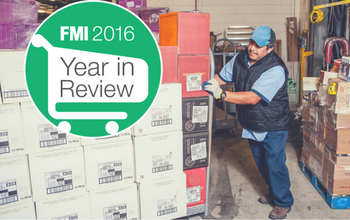By: Pat Walsh, Chief Business Development Officer, and Vice President of Supply Chain, Food Marketing Institute

Effective and efficient supply chains are a source of sustainable competitive advantage for retailers and wholesalers alike. The ability to optimize and transform supply chain capabilities requires collaboration with trading partners both on the physical movement of product and the information that enables smart supply chain forecasting and decision making. In 2016, the Trading Partner Alliance Supply Chain Committee established and prioritized its collaborative supply chain transformation efforts across four key areas:
- Focus on the Consumer
- Connect Business Information
- Talent Development
- Shared Supply Chain
Needless to say, many companies are re-evaluating their supply chain initiatives and capabilities to ensure they are well positioned to meet the needs of consumers in the rapidly changing digital and omnichannel retail world. Yet while many companies are focused on the future, today’s business environment demands relentless focus on superior execution of industry best practices designed to optimize supply chain performance.
The TPA On-Shelf Availability Committee released a study featuring a Root Cause Analysis and Industry Best Practices Guide to address out of stocks and areas for improvement. This study focused on process, organizational and metric gaps to include a deep drive understanding of the casual factors related to out of stocks featuring good, better, best and future practices to improve planning and execution in the end-to-end value chain.
Another key area is to reduce and mitigate risks to the shared supply chain. The TPA Hazardous Waste Taskforce is focused on the following key areas that require capabilities to ensure compliance:
- Address accurate information flow to identify which products are considered hazardous waste;
- Fix and improve product design to minimize risks;
- Address the disposal issue (process and compliance) to minimize costs;
- Develop industry best practices to identify, handle, transport and dispose of hazardous waste; and
- Address regulatory compliance issues.
Consistent with all these priority areas, FMI diligently focused on trend-tracking. Notably, we delivered an Industry Productivity Benchmark Report to address industry trends and opportunities for improvement in the areas of material handling, systems optimization, data management, developments in productivity drivers and capabilities, warehouse facility productivity, technology adoption and supply chain profitability.
FMI will continue in 2017 to focus on the future of supply chain transformation while concentrating on industry best practices today to drive business performance.


 Industry Topics address your specific area of expertise with resources, reports, events and more.
Industry Topics address your specific area of expertise with resources, reports, events and more.
 Our Research covers consumer behavior and retail operation benchmarks so you can make informed business decisions.
Our Research covers consumer behavior and retail operation benchmarks so you can make informed business decisions.
 Events and Education including online and in-person help you advance your food retail career.
Events and Education including online and in-person help you advance your food retail career.
 Food Safety training, resources and guidance that help you create a company food safety culture.
Food Safety training, resources and guidance that help you create a company food safety culture.
 Government Affairs work — federal and state — on the latest food industry policy, regulatory and legislative issues.
Government Affairs work — federal and state — on the latest food industry policy, regulatory and legislative issues.
 Get Involved. From industry awards to newsletters and committees, these resources help you take advantage of your membership.
Get Involved. From industry awards to newsletters and committees, these resources help you take advantage of your membership.
 Best practices, guidance documents, infographics, signage and more for the food industry on the COVID-19 pandemic.
Best practices, guidance documents, infographics, signage and more for the food industry on the COVID-19 pandemic.
